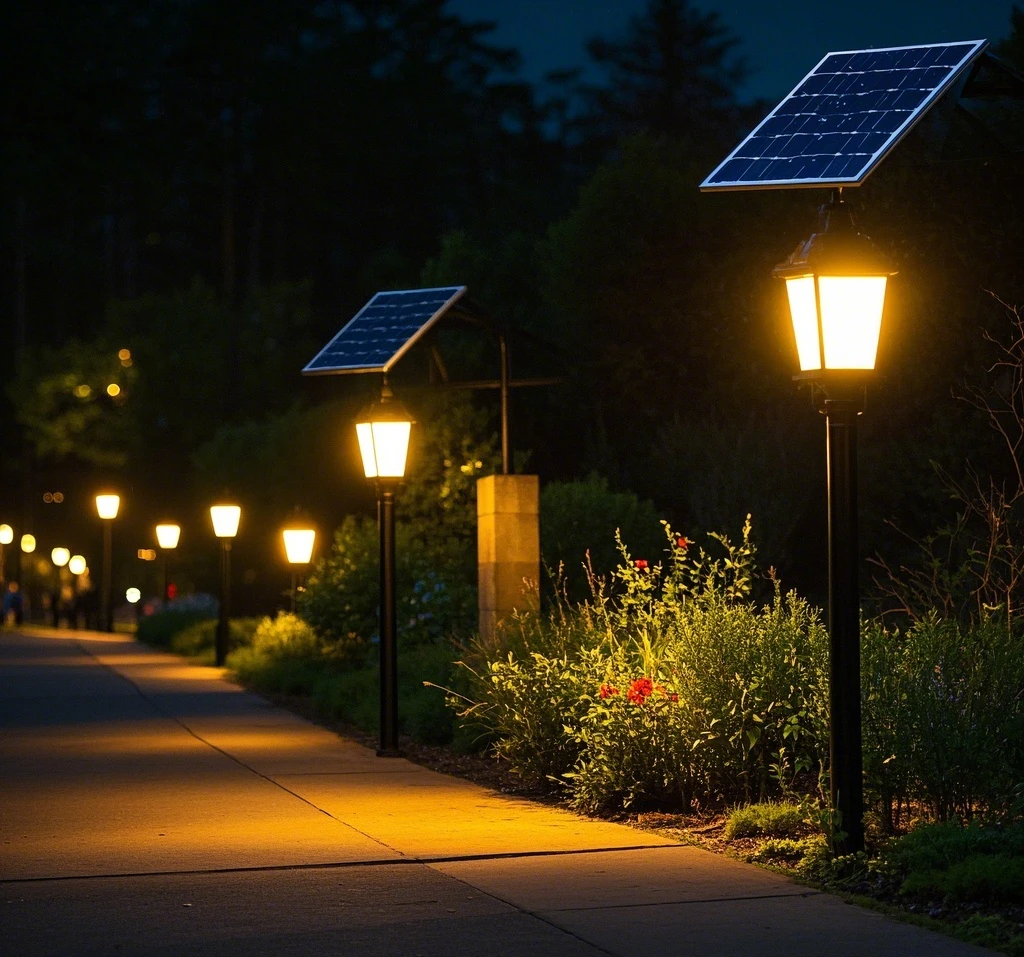Motion-sensor solar path lights have emerged as a must-have for modern homeowners, blending eco-friendly technology with enhanced security features. As sustainability and safety become top priorities, these lights offer a practical solution for illuminating outdoor spaces while reducing environmental impact and deterring unwanted activity. Powered by renewable solar energy and equipped with motion sensors, they minimize carbon footprints and provide targeted illumination to enhance home security. This article explores the environmental and safety benefits of motion-sensor solar path lights, supported by 2025 user reviews and case studies, demonstrating their real-world impact on energy savings and property protection.

Environmental Benefits of Solar Path Lights
Solar path lights are a cornerstone of sustainable outdoor lighting, harnessing renewable energy to reduce reliance on fossil fuel-based electricity. By converting sunlight into electricity via high-efficiency solar panels, such as monocrystalline cells found in products like the Outdoor Solar Store’s Modern Solar Pathway Light, these lights eliminate the need for grid power, significantly lowering carbon emissions. According to Nature journal, LED-based solar lighting can reduce global energy consumption by up to 50% compared to traditional incandescent lights, contributing to a smaller carbon footprint.
The eco-friendly design extends beyond energy use. Many models, such as the BITPOTT Motion Sensor Solar Landscape Spotlights, incorporate recyclable materials like aluminum and high-grade ABS plastic, minimizing environmental waste. Consumer Reports highlights that solar lights with IP65 or higher ratings, like the Beau Jardin Solar Pathway Lights, are built to withstand harsh weather, reducing the need for frequent replacements and further supporting sustainability. Additionally, motion sensors enhance energy efficiency by activating lights only when needed, conserving battery life and ensuring minimal energy waste. For instance, The Spruce notes that the URPOWER Solar Lights, with a 1200 mAh battery, can last up to 12 hours on a single charge, making them ideal for eco-conscious homeowners.
User reviews from 2025 underscore these environmental benefits. A homeowner in California, featured on Bob Vila, reported a 20% reduction in their monthly electricity bill after installing the Hampton Bay Parkwood Outdoor Solar Path Light along their driveway. By eliminating the need for wired lighting, they reduced energy costs while maintaining a well-lit property. Another user on Amazon praised the Linkind StarRay Solar Spot Lights for their durability and low maintenance, noting that the lights continued to function efficiently through rainy seasons, further reducing environmental impact by avoiding frequent replacements.
Security Advantages of Motion-Sensor Technology
Motion-sensor solar path lights significantly enhance home security by providing targeted illumination when movement is detected, deterring potential intruders and nocturnal animals. The passive infrared (PIR) sensors in models like the Ring Solar Pathlight detect motion within a 15–30-foot range, activating bright LEDs to illuminate pathways, entrances, or gardens. SafeWise emphasizes that well-lit properties are up to 84% less likely to be targeted by intruders, as highlighted in crime prevention studies. The sudden activation of lights can startle unwanted visitors, from raccoons to potential burglars, making these lights a powerful deterrent.
The security benefits are amplified by smart home integration. Lights like the Ring Solar Pathlight, compatible with Alexa and the Ring ecosystem, allow users to receive motion alerts via smartphone apps, as noted in Tom’s Guide. This feature enables real-time monitoring, enhancing peace of mind. For example, a 2025 user review on The Home Depot described how the Ring Solar Pathlight’s motion alerts helped them identify a stray dog entering their yard, preventing potential damage to their garden. Similarly, Popular Mechanics highlights the LeonLite Motion-Activated LED Security Light, which offers a 70-foot detection range, as an effective solution for large properties, with users reporting fewer incidents of nocturnal animal activity after installation.
Motion sensors also improve safety for residents by illuminating walkways and entrances, reducing the risk of trips and falls. BBC Gardeners’ World tested the 4lite Antheia LED Solar Spike Light, which activates at a 120-degree angle, ensuring safe navigation along uneven paths. A 2025 case study from SafeWise featured a suburban family who installed Baxia Technology Path Lights along their walkway, reporting improved visibility during evening walks and fewer disturbances from wildlife, such as possums, due to the motion-activated strobe mode.

Real-World Impact: Case Studies and User Feedback
Case studies and user reviews from 2025 provide compelling evidence of the practical benefits of motion-sensor solar path lights. A family in Texas, featured in Better Homes & Gardens, installed the AloftSun Solar Motion Sensor Outdoor Lights along their backyard path. They reported a 15% reduction in energy costs compared to their previous grid-powered lights, attributing savings to the lights’ efficient 2200 mAh battery and motion-sensor technology. The IP68 rating ensured durability through heavy rain, and the motion sensors deterred raccoons from rummaging through their trash bins, enhancing both security and cleanliness.
Another case study from The Solar Centre highlighted a UK homeowner who installed the Evo SMD Pro Solar Security Light near their front entrance. The light’s 700-lumen output and 30-meter detection range provided robust security, with the homeowner noting fewer signs of attempted break-ins after installation. The eco-friendly design also aligned with their goal of reducing their carbon footprint, as the lights required no additional electricity costs. Similarly, a Forbes review of the Linkind StarRay Solar Spot Lights praised their adjustable motion-sensing modes, with a user reporting that the lights’ dim-to-bright setting saved energy while ensuring their driveway was well-lit during late-night arrivals.
On Amazon, a 2025 review of the Nacinic LED Solar Motion Sensor Light described how its 650-lumen output and 270-degree beam angle improved visibility around a rural property, deterring deer and other animals from damaging crops. The user appreciated the easy installation and the lights’ ability to function in low-sunlight conditions, highlighting their reliability and eco-friendly operation. These real-world examples demonstrate how motion-sensor solar path lights deliver tangible benefits in both energy savings and enhanced security.
Key Features to Consider in 2025
When choosing motion-sensor solar path lights, several features ensure optimal performance and value:
- Brightness and Modes: Lights with 50–250 lumens, like the Outdoor Solar Store’s Modern Solar Pathway Light, offer versatility for ambiance and security. Adjustable modes, such as dim-to-bright or strobe, as seen in the HMcity 120 LED Solar Lights, cater to various needs (SafeWise).
- Battery Life: A battery capacity of 800–2200 mAh, as found in the AloftSun Spotlights, ensures 6–20 hours of operation. Bob Vila recommends replaceable batteries for long-term use.
- Weather Resistance: An IP65 or higher rating, like that of the X-Sense SSL21, ensures durability in extreme conditions (X-Sense). Materials like stainless steel or ASA plastic enhance longevity.
- Motion Detection Range: A range of 15–33 feet, as offered by the Ring Solar Pathlight or AloftSun Spotlights, provides adequate coverage for most residential needs (The Spruce).
- Ease of Installation: Wire-free designs with ground stakes or wall mounts, like the URPOWER Solar Lights, simplify setup (Better Homes & Gardens).
Challenges and Solutions
Despite their benefits, motion-sensor solar path lights face challenges. Performance can vary in low-sunlight regions, potentially reducing battery life. Tom’s Guide notes that models like the Aootek Solar Outdoor Flood Lights may require strategic placement to maximize solar exposure. Advances in battery technology, such as the 1500 mAh Li-ion battery in the Outdoor Solar Store lights, mitigate this by storing more energy. Additionally, high-end models like the Ring Solar Pathlight may require accessories like the Ring Bridge, increasing costs (Wirecutter). Budget-friendly options, such as the Baxia Technology Path Lights, offer similar features at a lower price point, as noted in SafeWise.
False triggers from small animals or insects can also be an issue. Ecavo suggests adjusting sensor sensitivity, as seen in the Tuffenough 3000LM LED Security Lights, to minimize unnecessary activations. Regular maintenance, such as cleaning solar panels with a soft cloth, as recommended by The Spruce, ensures consistent performance.
Conclusion
Motion-sensor solar path lights are an essential addition to modern homes, offering a powerful combination of eco-friendly operation and enhanced security. By harnessing solar energy, they reduce carbon footprints and energy costs, as evidenced by user reviews showing up to 20% savings on electricity bills. Their motion-sensor technology deters intruders and nocturnal animals while improving safety on walkways, with 2025 case studies demonstrating real-world impact. Top-rated products like the Outdoor Solar Store’s Modern Solar Pathway Light, Ring Solar Pathlight, and AloftSun Spotlights combine durability, smart features, and ease of use, making them ideal for sustainable and secure outdoor lighting. As technology advances, these lights will continue to illuminate homes smarter, greener, and safer.


Leave a Reply